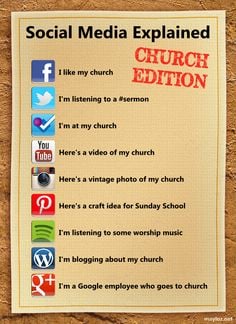Beyond the Bulletin - Church Social Media Tips and Strategy for Beginners
Market: Religious
Does your church need a social media program? The answer is a resounding “Yes!” Or, more specifically, “Yes, as long as you get it right.”
Social media is the fastest growing communications format, ever. Not since the Gutenberg Bible, the first major book created on a printing press in western civilization has any communication form had a more rapid or profound effect. In 2004, Facebook had 1M users. Today, it has nearly 1.5 Billion. Twitter, Google+, Pinterest, Instagram, and Flickr have all experienced tremendous, rapid growth. Social media can take at least partial credit in determining the outcome of elections and the fate of governments.
Why does it matter to churches? It matters because you have a message to send and social media is one of the fastest and least expensive ways to send it. It matters because no matter your church’s size, location or denomination, your church has a brand. More than 70% of brands today are represented on Facebook, and increasingly, organizations use a variety of social media channels to communicate with their followers.
We’re going to look at some of the key reasons for developing a church social media program and why a good social media strategy is more than just asking one of the tech-savvy teens in your Youth program to create a Facebook page for your church.
Church Social Media – Who Needs It? You Do!
Churches need social media because, more and more, it’s the way people communicate. At the end of 2013, nearly 75% of adults who are online use at least one social networking site. Facebook is the most widely used network, but Twitter is now the fastest-growing. More women used social media than men, but men use Twitter at a higher rate than women, particularly young men. What church doesn’t need to improve its ability to communicate with young (Age 19-29) men?
Clearly, a case exists for churches to use social media as part of its communication strategy. But before creating a new page or sending that first tweet, be sure to do your homework and plan the best strategy for your congregation. The following church social media tips will help you make a successful start in social media.
Church Social Media – Tips, Strategies & ROI
Define your goals. Do you hope to grow your congregation? Raise money? Reach out to the community or to a particular age group? Communicate your conviction that a faith-driven life adds meaning and richness to our lives? All of the above?
Too many times, organizations, not only churches, start using social media without a clear understanding of what they hope to accomplish. This results in scattered, unfocused posts that do little to engage followers.
Determine how you will measure your effectiveness. What you measure should be linked to your objectives. If your goal is simply to build awareness of your church, a good measure would be the number of “Likes” on Facebook or the number of followers on Twitter, and any increases in those numbers. If your goal is to raise money for a particular project, the measurement is easy. Did you reach your goal and how much of it was the result of church social media use?
If, however, your goal is less clearly defined, measurement is a bit more challenging. If your goal is to encourage families to discuss the role of Christ in their lives, how will you know if it’s working? In this case, it’s helpful to create specific campaign goals. State your intention on your social media networks and follow incremental steps throughout the campaign.
For example, one Midwest church wanted to create a discussion around incorporating Jesus into daily lives. The church created a campaign called “Take Jesus with You.” The church distributed Flat Jesus dolls similar to the Flat Stanleys found in schools. They encouraged congregants to include Jesus in daily activities, then take a picture and post it on the church’s Facebook page. Jesus soon appeared at an annual conference, the mall, the library, local festival, the farmers’ market and family vacations. One of the most surprising aspects of the campaign was the number of older adults who participated, snapping and uploading selfies using their smartphones. Next, the church asked people to comment on the impact of carrying Jesus along – the impact on their behavior or thinking. The church “measured” the effectiveness of the initiative based on the number of photos and comments posted, along with the resulting likes and shares. Measurement matters.
- Choose the right channels for your congregation. First, identify the channels your congregation is already using and start there.
- Conduct a quick survey to determine their preferences. Young people are increasingly drawn to Twitter and away from Facebook; too many of their parents are on Facebook! Young women and mothers are the main users of Pinterest and Instagram, both of which are image-based.
- Identify one person to be the coordinator and voice of your church. Decide on a tone – formal or casual, just the facts or chatty – and be consistent. Having one person write posts creates a constant voice that followers come to know and recognize.
- Develop and communicate a plainly stated church social media policy that outlines acceptable and unacceptable posts on your sites. Be ready to remove offensive or inappropriate comments.
- Always, always respond to comments. If someone takes the time to comment on one of your posts, respond quickly. A quick thank you will suffice, but engaging them in a give and take raises the visibility of your subsequent posts, and you might just learn something about the responder.
- Welcome more people to the network. A church in Kentucky follows all the other churches in their town, along with area businesses and non-profits. Help people in the congregation become more comfortable with digital technology by hosting workshops that teach basic skills. This is a wonderful opportunity for an intergenerational activity.
Finally, never give up and never stop learning. Social media’s constantly changing face requires diligence. Be patient and consistent with your church social media program. Engage sincerely. Your efforts will be rewarded.

